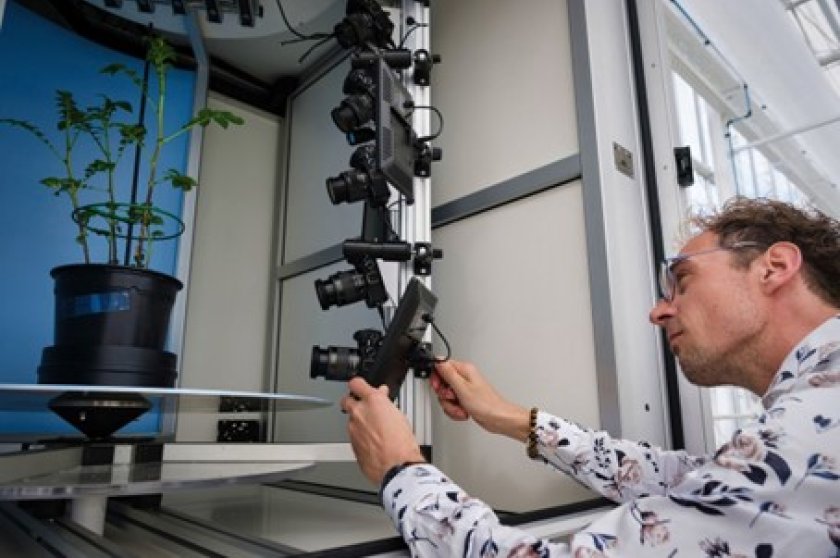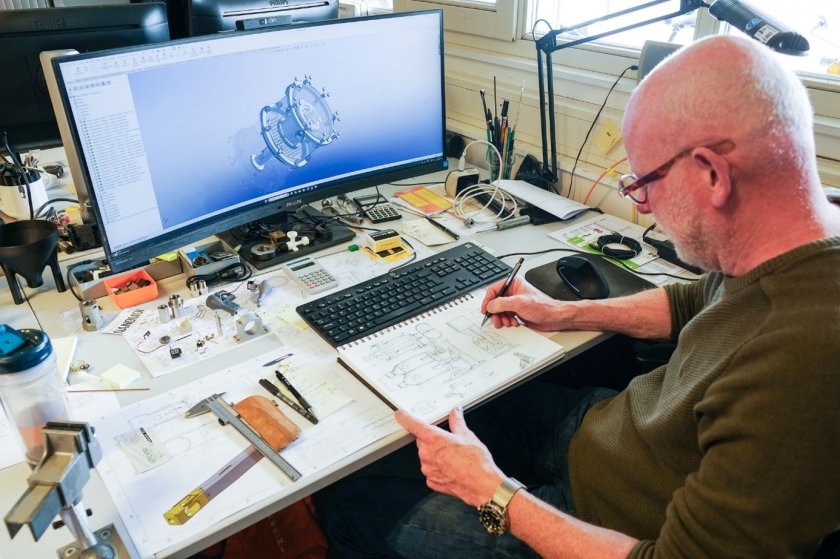
Wageningen workshop offers innovative solutions for research
How to investigate a scientific question when the necessary measuring instruments simply do not exist? It is precisely with challenges like these that you can turn to Wageningen Technical Solutions (WTS), the workshop and instrument making facility of Wageningen University & Research. We took a look behind the scenes.

Walking through the coffee room into the workshop towards the office, we pass workbenches full of tools, pipes in all imaginable sizes, and a human-sized structure with a large blue sphere attached to it. We have barely sat down in the office with group head Erwin Beckers and team leader Eric Karruppannan when a researcher knocks on the door: “Do you have a moment?” It is about a new project. A coincidence? Certainly not, according to Beckers. “Every time during our weekly meetings, at least one researcher knocks on the door for help.” And at Wageningen Technical Solutions, they are more than happy to help indeed.
Every time during our weekly meetings, at least one researcher knocks on the door for help.
Time machine for plants
This is also the case with Johan Bucher’s project. He studies how plants grow and develop. But as a researcher, you cannot sit next to a plant 24 hours a day to record the growth process. “Crucial moments always occur when you have a day off or are celebrating a special occasion,” Bucher says, laughing. “Too often, I had to tell my boss: we will have to try again next year.” Together with WTS, he developed a small two-by-two-metre chamber: a plant growth chamber equipped with a light source and moving cameras that capture the plant’s growth from all angles, 24 hours a day.
It does not sound very complicated: a small box with a lamp and some cameras. Can you not just build that yourself? That was Bucher’s initial thought as well. Using aluminium profiles from a hardware store and a cheap camera robot, he constructed his first prototype in his living room. With that 'guarded' growth chamber, he couldn't miss any big moments, or so he thought. “But plants are constantly moving: they turn towards the light and bend their leaves,” says the researcher. Due to the chamber’s limited size, parts of the plant still fell out of the picture or rotated away from the camera.

That was the moment Bucher turned to WTS. He showed Rick Hendriksen the system he had built at home and together they brainstormed about a better version. One that would capture everything and in which the plants grow optimally. Together, and with the help of colleague Matthijs Brouwer, they designed a new growth chamber where the camera circles the plant and continuously takes pictures. Hendriksen also developed a new irrigation system that provides the plant with water evenly, just like in nature.
We always have to put ourselves in the researcher’s shoes and understand their research. That is what makes our work so fun and rewarding.
Understanding the researcher’s perspective
The interaction between researchers and engineers that comes with every assignment is what team leader Karruppannan finds so great. “We always have to put ourselves in the researcher’s shoes and understand their research,” he explains. “We brainstorm together, build upon each other’s ideas and keep the big picture in mind; that is what makes our work so fun and rewarding.” Every project starts with a discussion where the researcher explains what they want to investigate. “If we also do not know of any existing equipment that can do the job, our work starts,” says Karruppannan.

Emeritus Professor Johan van Leeuwen, who specialises in Animal Mechanics, has collaborated with WTS multiple times throughout his career. He describes the collaboration as very pleasant. “When brainstorming about a new measuring setup, we listen to each other’s input and select the best ideas. Sometimes, you realise your ideal setup is practically impossible, or the workshop technicians suggest leaving out certain aspects to make the system more robust. Because the more complicated the equipment, the more prone it is to errors. Either way, they always deliver quality, and every time the result exceeds my expectations.”
Simple yet robust solutions
Not every project requires high-tech solutions. “At another university workshop, I once saw a beautifully crafted curved wooden bracket,” says Johan Belgraver from behind his workbench at WTS. “It looked fantastic and took a lot of time and effort to make. But you can achieve the same result by bending a piece of stainless steel, which is much quicker to do.” That philosophy guides Belgraver and his colleagues: always finding the best, yet simplest or most effective, way to help researchers. This not only saves on material costs and labour time, but also allows scientists to go on their research more quickly.
“That is exactly what I am working on now,” Belgraver says, pointing to a cheese mould on his workbench: a white, round plastic container with small holes designed to press cheese during production. During that process a weight on top helps to press the cheese. However, the researcher using it faced an issue: the cheese would often tilt during pressing. Belgraver’s solution? A larger plate on top, held stable by four large screws. “This way, the plate applies equal pressure on every part of the cheese,” he explains. Perhaps not the most glamorous solution, but certainly an effective and robust one.

Van Leeuwen recognises the effective and robust outcome of the work of WTS. In his department, scientists unravel the movement mechanisms of animals. "The measurement setups we need for that often do not exist." For example, Van Leeuwen and his colleagues investigated the flight behaviour of bumblebees with high-speed cameras and square tunnels with propellers that simulated wind. "But the propellers created unwanted turbulence," says Van Leeuwen. At the workshop, the technicians used tricks such as multiple layers of gauze in the tunnel to limit the turbulence, so that the researchers could continue their research.
Repairs and sustainability
The instrument workshop handles many exciting projects where technicians can unleash their creativity. But that is not all they do. This becomes evident from the high, fully loaded cart near the entrance, filled with measuring instruments and devices, including a benchtop centrifuge, all awaiting repairs. That too, they do here at WTS. “Repairing is much more sustainable than buying new equipment,” says Karruppannan. “If specific parts need to be replaced, we call the suppliers – technician to technician. We often find they are more willing to send a particular part to us than if a researcher requests it.”

Here, it is all about finding solutions, so that scientists can focus on their research again.
Whether it is a high-tech solution full of with advanced features, a quick and elegant fix for a minor problem, or a repair of existing equipment: it is clear that WTS has everything needed to support researchers on campus. It is the place where technology and science come together. Thanks to their expertise and collaboration with researchers, the employees at WTS develop unique measuring instruments, helping to push the boundaries of research. “We like to help, no matter how big or small the challenge,” says Karruppannan. “Here, it is all about finding solutions, so that scientists can focus on their research again.”
Bucher also benefits from this with his ‘plant time machine’. Nowadays, he can easily record time-lapse videos of growing plants. With the press of a button, he can digitally rewind or fast-forward a plant’s life. He can also examine the plant from any angle and zoom in as if he were standing in front of it with a magnifying glass. The details are so precise that he can easily calculate the surface area of each leaf in the software. Thanks to Wageningen Technical Solutions, he never has to miss another crucial moment in the life of a plant.

Are you looking for measuring instruments that are not available on the market? Or are you struggling with issues related to your current equipment? Contact Wageningen Technical Solutions via Eric Karruppannan.